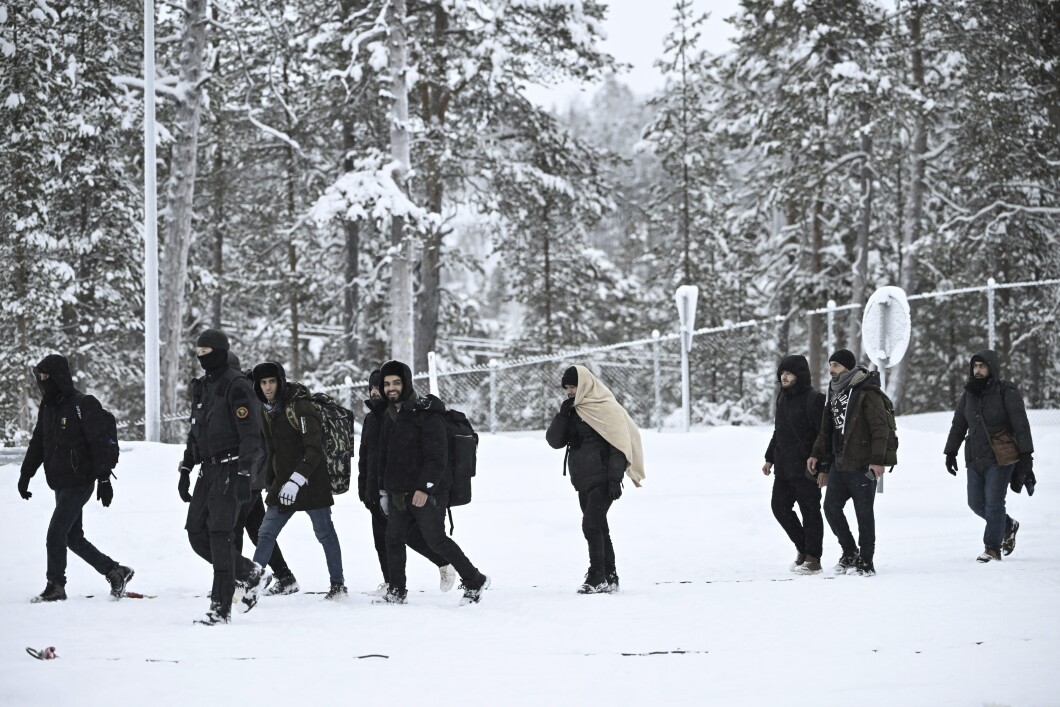
Russia has orchestrated an influx of immigrants into Finland, a “hybrid operation” that has forced NATO’s newest member to close its eastern border.
“Russia is enabling the instrumentalization of people and guiding them to the Finnish border in harsh winter conditions,” Finnish Prime Minister Petteri Orpo said Tuesday. “Finland is determined to put an end to this phenomenon.”
FEDERAL COURT TO WEIGH AMTRAK BID TO TAKE DC’S UNION STATION IN EMINENT DOMAIN CASE
More than 800 people have arrived at Finnish border crossings over the last month, with the asylum-seekers “predominantly from the Middle East and Africa,” according to Voice of America. Western officials characterized the new surge as “yet another” attempt by Russia to find unconventional ways to threaten NATO.
“We have seen them using energy, we have seen them using cyberattacks, we have seen them using different kinds of clandestine operations to try to undermine our democracies,” NATO Secretary-General Jens Stoltenberg said on Tuesday at a meeting of NATO’s top diplomats in Brussels. “The fact that Russia is now using migration as a tool is yet another example of the attempt to put pressure on neighbors, NATO allies, and they will not succeed because we stand together.”

As Finnish authorities finalized their plan to close the last border crossing with Russia, Moscow issued a new rebuke of the Nordic state’s decision to join the trans-Atlantic alliance.
“Evidently, the entire [NATO] alliance has increased the zone of contact with its main enemy, as Russia is viewed by the alliance, by 1,300 kilometers,” Russian Deputy Foreign Minister Alexander Grushko said at a foreign affairs discussion in Moscow, referring to the 830 mile-long border the two countries share. “And they will demand that Finland do what other allies are doing, i.e., take all necessary measures and deploy foreign forces on its territory. We know that Finland has signed relevant bilateral agreements.”
Finland and Sweden, which both maintained neutrality throughout the Cold War after the Finns fought Soviet invaders to a standstill in 1939, applied to join NATO last year in the months following Russian President Vladimir Putin’s initiation of a full-scale campaign to overthrow the Ukrainian government. Russian Foreign Minister Sergey Lavrov’s department warned that Moscow would “take military-technical and other retaliatory measures” when Finland’s membership of the alliance was finalized in April.
“We work closely with our Finnish partners and they report a significant increase in third-nation citizens that are coming via Russia to their border, clearly orchestrated by Russia in order to create hybrid pressure on Finland.” Norwegian Foreign Minister Espen Barth Eide told CNBC on the sidelines of the NATO meeting in Brussels. “This is an example that when you are in war, you have a kinetic war on the battlefield, occasional attacks on infrastructure, but also these other measures which we tend to call ‘hybrid.’”
Stoltenberg, for his part, emphasized that the border trouble has not developed into the sort of security issue that would require a response from the alliance.
“There has been no request for a NATO increased presence,” he said before noting that the European Union already is coordinating with Finland. “Border control is something that allies do themselves also sometimes with support from EU agencies, and I’m absolutely confident that Finland is capable of dealing with this themselves and therefore I trust they’re absolutely made the right decision when it comes to controlling their borders.”
Against the backdrop of a war between Israel and Hamas, the arriving immigrants stoke antecedent Western anxiety about potential terrorist threats, according to another NATO member state official.
“The internal security services are worried about the possibility of the wave of terrorism, and then suddenly you will have a rising wave of Middle East so-called ‘refugees’ which are not reaching naturally to your northern border crossing points,” a senior European official told the Washington Examiner. “It’s absolutely state-organized.”
This official downplayed the idea of Russia ferrying any known terrorists to the Finnish border on account of logistical difficulties. “They can use whatever tools,” the official added, “but they are not almighty. So, their organizing capabilities have limits as well, actually. So, it’s not so easy.”
Finnish Foreign Minister Elina Valtonen acknowledged a more general misgiving about the potential for “aftershocks” from the crisis in the Middle East.
“We are prepared and we are preparing for possible aftershocks,” she said in a separate broadcast interview in Brussels. “There has to be a lasting negotiated two-state solution for the region because no outflux of migrants will ever solve the issue.”
CLICK HERE TO READ MORE FROM THE WASHINGTON EXAMINER
Valtonen expressed “hope that Russia gets back to normal where they respect our treaties,” but Lavrov’s subordinates so far have denied responsibility for the issue. In the meantime, Finnish authorities have decided to close the land border for at least two weeks.
“In the current situation, it is necessary to close the entire eastern border,” Finnish Interior Minister Mari Rantanen said. “We have taken this decision to protect Finland’s national security against this Russian hybrid operation.”






